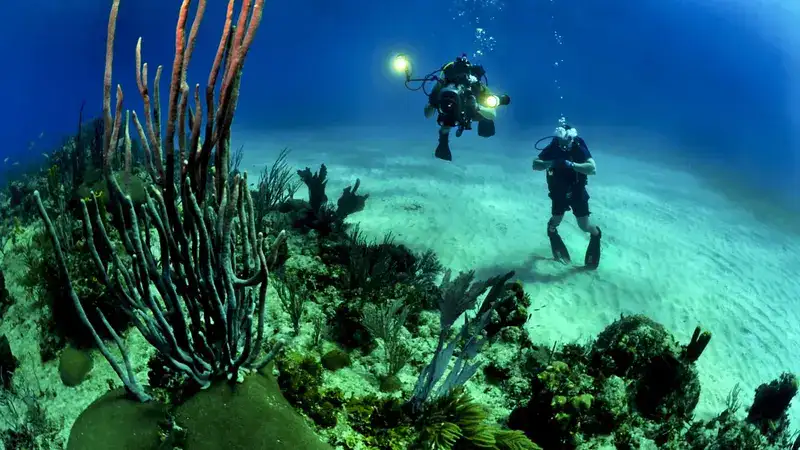Ocean Exploration, covering over 70% of the Earth’s surface, remains one of the most mysterious and unexplored realms of our planet. The underwater world, from the sunlit surface to the dark abyssal zones, is a vast expanse teeming with diverse life forms, unique ecosystems, and untapped resources. This article delves into the wonders of the underwater world, highlighting its significance, the challenges of exploring it, and the need for conservation.
The Mysteries Beneath the Waves
Ocean Exploration is divided into several layers, each with distinct characteristics. The epipelagic zone, or the sunlight zone, extends to about 200 meters below the surface. This zone is home to a wide variety of marine life, including whales, sharks, and colorful coral reefs. Beyond this, the mesopelagic zone, or twilight zone, ranges from 200 to 1000 meters deep. Here, the light fades, and bioluminescence becomes more prevalent among marine creatures.
Further down lies the bathypelagic zone, or the midnight zone, which stretches from 1000 to 4000 meters. This area is pitch dark, and creatures such as giant squids and anglerfish have adapted to survive in the extreme conditions. The deepest part of the ocean, the hadalpelagic zone, or the hadal zone, extends below 6000 meters and is found in the deepest ocean trenches. This zone remains largely unexplored due to its extreme pressures and inaccessibility.
The Ocean’s Zones: A Deep Dive into its Layers
1. The Epipelagic Zone (Sunlight Zone)
The epipelagic zone, extending from the surface to about 200 meters deep, is the ocean’s most illuminated layer. Sunlight penetrates this zone, supporting photosynthesis and a wealth of marine life. Coral reefs, which are biodiversity hotspots, thrive here, providing habitats for myriad species including fish, crustaceans, and marine plants. This zone also includes the pelagic region, where open-water species like dolphins, sharks, and large schools of fish roam.
2. The Mesopelagic Zone (Twilight Zone)
Beneath the epipelagic zone lies the mesopelagic zone, extending from 200 to 1000 meters deep. This zone receives minimal sunlight, creating a twilight environment. Adaptations in this zone include bioluminescence, where organisms like jellyfish and deep-sea squid produce their light. The mesopelagic zone is also where the thermocline—a layer of rapid temperature change—occurs, influencing ocean currents and marine life distribution.
3. The Bathypelagic Zone (Midnight Zone)
The bathypelagic zone ranges from 1000 to 4000 meters deep and is characterized by complete darkness. Here, temperatures are just above freezing, and the pressure is immense. Life forms in this zone have adapted to the harsh conditions, with features such as large eyes to detect faint light and unique feeding strategies to cope with the scarcity of food. Notable residents include giant squids, deep-sea anglerfish, and giant tube worms.
4. The Hadalpelagic Zone (Hadal Zone)
The hadalpelagic zone, found in ocean trenches and deep-sea environments below 6000 meters, is the deepest and most extreme part of the ocean. The pressure here is over 1000 times atmospheric pressure, and temperatures are near freezing. This zone remains largely unexplored, with only a few manned and unmanned submersibles reaching these depths. Species adapted to this environment include hadal snails and certain types of deep-sea fish that can withstand extreme pressure.
The Challenges of Ocean Exploration
Exploring the underwater world presents significant challenges. The immense pressure, cold temperatures, and darkness make deep-sea exploration both technologically and physically demanding. Submersibles and remotely operated vehicles (ROVs) have allowed scientists to reach greater depths, but many areas of the ocean remain inaccessible.
Technological Challenges in Ocean Exploration
Exploring the ocean’s depths is fraught with challenges due to its immense scale and extreme conditions. The primary difficulties include:
1. Extreme Pressure: The pressure increases by approximately one atmosphere for every 10 meters of depth, reaching over 1000 atmospheres in the highest zone. Specialized equipment, such as pressure-resistant submersibles and ROVs, is required to withstand these conditions.
2. Cold Temperatures: Deep-sea temperatures hover just above freezing, requiring technology that can operate reliably in these frigid environments.
3. Limited Visibility: With the absence of natural light beyond the epipelagic zone, visibility is limited, making navigation and observation challenging. Researchers use sonar and artificial lighting to explore and document underwater environments.
4. Vastness and Depth: The sheer size of the ocean and the depth of its trenches mean that exploration is a slow and expensive process. Mapping the ocean floor and studying its ecosystems requires significant resources and time.
The Importance of Ocean Conservation
The Ocean Exploration plays a crucial role in regulating the Earth’s climate, providing oxygen, and supporting a vast array of life forms. Coral reefs, often referred to as the “rainforests of the sea,” are vital for marine biodiversity and serve as important resources for many coastal communities.
Human activities, such as overfishing, pollution, and climate change, pose significant threats to ocean health. Plastic pollution, in particular, has reached alarming levels, with microplastics found even in the most remote areas. Conservation efforts are essential to protect marine environments and ensure the sustainability of ocean resources.
The Ocean Exploration, a crucial component of Earth’s biosphere, plays a pivotal role in regulating climate, supporting biodiversity, and providing essential resources for human life. As we face growing environmental challenges, the importance of ocean conservation cannot be overstated. This article explores why protecting the ocean is vital and how our actions impact its health.
1. Regulating Climate and Weather Patterns
The ocean is a major driver of global climate and weather patterns. It absorbs and stores vast amounts of solar energy, influencing temperature and weather systems. Ocean currents, such as the Gulf Stream, transport warm water and regulate temperatures across continents. This heat distribution helps moderate climate, affecting everything from rainfall patterns to storm intensities.
By conserving the ocean, we ensure the stability of these critical processes. Disruptions, such as those caused by climate change, can lead to more extreme weather events, altered climate patterns, and rising sea levels, impacting ecosystems and human communities worldwide.
3. The “Matilda” franchise:
The net worth of the “Matilda” franchise, including book sales, movie adaptations, stage productions, and merchandise, is estimated to be in the hundreds of millions of dollars. However, an exact figure is difficult to determine.
2. Supporting Biodiversity
The ocean is home to an incredible diversity of life, from the smallest plankton to the largest whales. Coral reefs, seagrass beds, and mangrove forests are some of the most productive and diverse ecosystems on Earth. They provide habitat and breeding grounds for countless marine species and contribute to the overall health of the oceanic environment.
Protecting these ecosystems is essential for maintaining marine biodiversity. Overfishing, habitat destruction, and pollution threaten these habitats, leading to declines in species populations and loss of biodiversity. Conservation efforts help preserve these vital ecosystems, ensuring the survival of marine species and the stability of oceanic systems.
3. Providing Resources and Livelihoods
The Ocean Exploration provides resources that are vital to human survival and economic activity. It is a primary source of food, with billions of people relying on fish and other seafood for their protein needs. Additionally, the ocean supports industries such as shipping, tourism, and recreation, contributing significantly to the global economy.
Sustainable management of ocean resources is critical to ensure their availability for future generations. Overfishing and pollution can deplete fish stocks and damage marine environments, threatening food security and economic stability. By adopting sustainable practices and protecting marine habitats, we can safeguard these essential resources.
4. Enhancing Human Health and Well-Being
The health of the ocean is closely linked to human health and well-being. Clean oceans provide safe and recreational spaces for swimming, diving, and other activities that contribute to physical and mental health. Furthermore, ocean ecosystems, such as mangroves and seagrasses, help filter pollutants and improve water quality.
Pollution and habitat destruction, however, can negatively impact these benefits. Contaminated waters and damaged ecosystems pose health risks to communities that rely on the ocean for their livelihood and recreation. Conservation efforts help ensure clean and healthy ocean environments that support human well-being.
5. Addressing Climate Change
The ocean plays a significant role in mitigating climate change. It absorbs about a quarter of human-induced carbon dioxide emissions, helping to reduce the impact of greenhouse gases on global temperatures. Additionally, oceanic processes, such as the carbon cycle and the storage of carbon in marine sediments, are crucial in regulating atmospheric carbon levels.
Protecting the ocean helps maintain its capacity to act as a carbon sink. Healthy marine ecosystems, such as mangrove forests and seagrass meadows, are particularly effective at sequestering carbon. Conservation and restoration of these ecosystems contribute to climate change mitigation efforts and help stabilize atmospheric carbon levels.
6. Promoting International Collaboration
Ocean conservation requires global cooperation due to the interconnected nature of marine environments. International agreements, such as the United Nations Convention on the Law of the Sea (UNCLOS) and the Paris Agreement, aim to address global ocean issues and promote sustainable management.
Collaboration among nations, organizations, and communities is essential for addressing challenges such as marine pollution, overfishing, and habitat destruction. By working together, we can develop and implement effective conservation strategies, share knowledge, and support efforts to protect the ocean on a global scale.
Conservation and the Importance of Protecting Marine Environments
The health of the ocean is crucial to the well-being of the planet. Key conservation issues include:
1. Overfishing: Overfishing depletes fish stocks and disrupts marine ecosystems. Sustainable fishing practices and the establishment of marine protected areas are vital to maintaining fish populations and ocean health.
2. Pollution: Marine pollution, particularly from plastics, has become a significant threat. Plastics degrade into microplastics, which are ingested by marine organisms and enter the food chain. Reducing plastic use and improving waste management are essential steps in combating pollution.
3. Climate Change: Rising sea temperatures and ocean acidification, driven by climate change, impact marine life and ecosystems. Coral bleaching and shifts in species distribution are consequences of a changing climate. Efforts to mitigate climate change and protect vulnerable species are critical for preserving ocean health.
4. Habitat Destruction: Activities such as trawling and coastal development can damage important habitats like coral reefs and mangroves. Conservation initiatives aimed at preserving these habitats are crucial for supporting biodiversity and ecosystem services.
The Future of Ocean Exploration and Research
The future of ocean exploration is promising, with advancements in technology and increased international collaboration opening new possibilities. Innovations such as deep-sea drones, advanced imaging techniques, and artificial intelligence are enhancing our ability to explore and understand the ocean.
Ongoing research efforts focus on mapping the ocean floor, discovering new species, and studying the impacts of human activities. By investing in ocean science and fostering global partnerships, we can unlock the secrets of the deep and ensure the sustainable management of ocean resources. For more information visit my website worldexploremag
Conclusion
the underwater world of the ocean is a realm of incredible diversity and mystery. As we continue to explore and understand its depths, we must prioritize conservation efforts to preserve its health and ensure its sustainability for future generations. The ocean remains a powerful reminder of the beauty and complexity of our planet, urging us to protect and cherish its wonders.
the underwater world of the ocean is a realm of profound mystery and beauty. As we continue to explore its depths, it is crucial to balance our curiosity with a commitment to conservation. Protecting the ocean and its ecosystems ensures that future generations can continue to marvel at the wonders of this vast and vital part of our planet.



